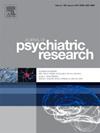童年创伤和成年压力对强迫症症状的影响:炎症标志物和丘脑功能连通性的作用
IF 3.7
2区 医学
Q1 PSYCHIATRY
引用次数: 0
摘要
背景:越来越多的证据表明,童年创伤和成年压力是强迫症(OCD)发展的重要因素。然而,创伤和压力影响强迫症的生理机制尚不清楚。本研究的目的是探讨炎症和丘脑功能连接是否介导创伤、压力和强迫症发展之间的关系。方法采用耶鲁-布朗强迫症量表(Y-BOCS)、童年创伤问卷(CTQ)和感知压力量表(PSS)对105名强迫症患者和55名健康对照进行评估。静息状态功能MRI和血浆分析用于测量脑连通性和炎症标志物。结果强迫症组的儿童创伤、压力和炎症水平明显高于对照组。炎症标志物升高与丘脑亚区与关键皮质区域(包括背外侧前额叶皮层和顶叶上回)之间的功能连通性下降相关,这与强迫症症状的严重程度和儿童创伤呈负相关。通径分析表明,应激在童年创伤与强迫症的关系中起中介作用,丘脑功能连通性在炎症因子与强迫症的关系中起中介作用。结论炎症和丘脑连通性在强迫症病理生理中的重要作用,可能部分揭示创伤和应激的致病机制,提示治疗干预的潜在靶点。本文章由计算机程序翻译,如有差异,请以英文原文为准。
The effects of childhood trauma and adult stress on obsessive-compulsive symptoms: the role of inflammation markers and thalamic functional connectivity
Background
Emerging evidence suggests that childhood trauma and adult stress are significant contributors to the development of obsessive-compulsive disorder (OCD). However, the physiological mechanisms by which trauma and stress influence OCD remain unclear. The aim of this study was to investigate whether inflammation and thalamic functional connectivity mediate the relationship between trauma, stress, and the development of OCD.
Methods
A cohort of 105 participants, including 50 individuals with OCD and 55 healthy controls, was assessed using the Yale-Brown Obsessive-Compulsive Scale (Y-BOCS), Childhood Trauma Questionnaire (CTQ), and Perceived Stress Scale (PSS). Resting-state functional MRI and blood plasma analysis were used to measure brain connectivity and inflammatory markers.
Results
Significantly higher levels of childhood trauma, stress, and inflammation were observed in the OCD group compared to controls. Elevated inflammatory markers were associated with decreased functional connectivity between thalamic subregions and key cortical areas, including the dorsolateral prefrontal cortex and superior parietal gyrus, which was negatively correlated with the severity of OCD symptoms and childhood trauma. Path analysis suggested that stress mediates the relationship between childhood trauma and OCD symptoms, and thalamic functional connectivity could serve as mediator between inflammatory factor and OCD.
Conclusions
These findings highlight the critical role of inflammation and thalamic connectivity in the pathophysiology of OCD, which may partly reveal the pathogenic mechanism of trauma and stress, suggesting potential targets for therapeutic intervention.
求助全文
通过发布文献求助,成功后即可免费获取论文全文。
去求助
来源期刊

Journal of psychiatric research
医学-精神病学
CiteScore
7.30
自引率
2.10%
发文量
622
审稿时长
130 days
期刊介绍:
Founded in 1961 to report on the latest work in psychiatry and cognate disciplines, the Journal of Psychiatric Research is dedicated to innovative and timely studies of four important areas of research:
(1) clinical studies of all disciplines relating to psychiatric illness, as well as normal human behaviour, including biochemical, physiological, genetic, environmental, social, psychological and epidemiological factors;
(2) basic studies pertaining to psychiatry in such fields as neuropsychopharmacology, neuroendocrinology, electrophysiology, genetics, experimental psychology and epidemiology;
(3) the growing application of clinical laboratory techniques in psychiatry, including imagery and spectroscopy of the brain, molecular biology and computer sciences;
 求助内容:
求助内容: 应助结果提醒方式:
应助结果提醒方式:


